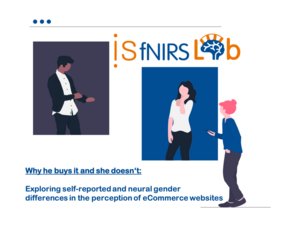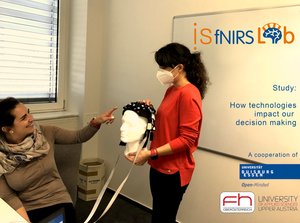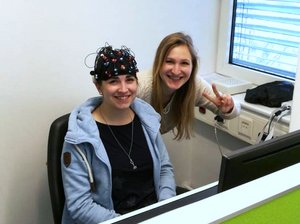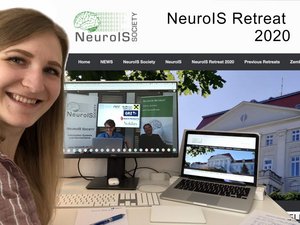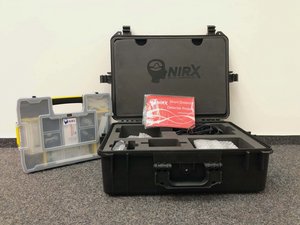fNIRS Lab - A laboratory for applied NeuroIS research
NeuroIS fNIRS Lab
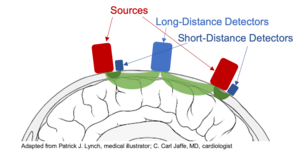
Our NeuroIS Lab is equipped with the neuroimaging method of functional near-infrared spectroscopy (fNIRS). fNIRS allows us to measure neural cortical activity of the human (or animal) brain. This enables us to measure critical processes in decision making, cognitive processing of information and emotional (neural) responses. These measurements go beyond the usual research methods of business information systems in the sense of observations, interviews, and questionnaires and thus, they provide a deeper understanding of human information processing.
What fNIRS actually measures:
fNIRS uses the ability to send light through tissue. Thereby, light of specific wavelengths is reflected by oxygenated hemoglobin or absorbed by deoxygenated hemoglobin. The reflected or absorbed light can be recorded with detectors, which allows us to calculate the oxygen contained in the blood. This provides an accurate measurement of local neural activity, since increased oxygen levels are an indicator for increased neural activity of the given area. In order to reach the cortical brain regions without too much light being reflected by extracerebral tissue, the sources and detectors of fNIRS should be approximately 30 mm apart. In order to intercept light which is reflected on the surface due to the blood circulation of skin and bone, and to filter it out as an interfering signal, so-called short channels are can be used. At the same time, short channels also serve as detectors, but with the difference that they should have a maximum distance of 10 mm from the sources to make sure only extra-cerebral light is received.
By using light and the associated measurement of hemoglobin, fNIRS measures so-called hemodynamic responses to shown stimuli. This is the same phenomenon as measured by functional magnetic resonance imaging (fMRI), but unlike fMRI, fNIRS can be used in a natural environment. This is particularly advantageous for IS, since effects are often not independent and isolated from each other.
Studienablauf und Studienteilnahme
An unseren Studien teilnehmen und jedes mal 10€ verdienen.
Info für Studierende - Probanden gesucht!
In unserem Lab führen wir viele verschiedene Studien durch und dafür brauchen wir natürlich immer auch Probanden! Und hier kommt ihr ins Spiel - an unseren Studien kann grundsätzlich jeder teilnehmen. Bei Teilnahme bekommt ihr die Zeit die ihr aufwendet natürlich auch entgolten - dabei lehnt sich die Höhe der Bezahlung an die Dauer der Studie an. Wenn ihr z.B. 45-60 Minuten teilnehmen müsst, so bekommt ihr eine Vergütung von 10€ dafür.
Wie unsere Studien grundsätzlich ablaufen:

Ein paar Beispiele zu den Aufgaben, die ihr in unseren Studien machen müsst:
- Ihr schaut euch verschiedene Webseiten an und bewertet diese anhand bestimmter Kriterien
- Oder ihr benutzt eine Webseite, um online etwas einzukaufen
- Oder ihr bekommt die Aufgabe, etwas auswendig zu lernen mit verschiedenen Medien, um zu schauen welches Medium euch besser beim lernen unterstützt
- Oder ihr schaut euch Bilder oder Videos zu Robotern an und dürft diese bewerte.
Um Proband zu werden müsst ihr euch nur in das folgende Formular eintragen und schon seid ihr dabei!
Technische Lab Ausstattung und Anwendungsgebiete
Technical specifications of the lab:
- Mobile NIRSport from NIRX with 8 sources & 8 detectors, plus additional 8 short-channel detectors
- All optodes can be equipped with spring-loaded optode holders
- Wavelengths of light are 760nm and 850nm
- Sampling rate is 7.81Hz
- For recording, a Lenovo ThinkPad (Intel i5 @1.8GHz, 16GB RAM) with appropriate software is available (NIRStar, NIRSite, nirsLab, NIRStim, Matlab Brain AnalyzIR Toolbox, Homer2)
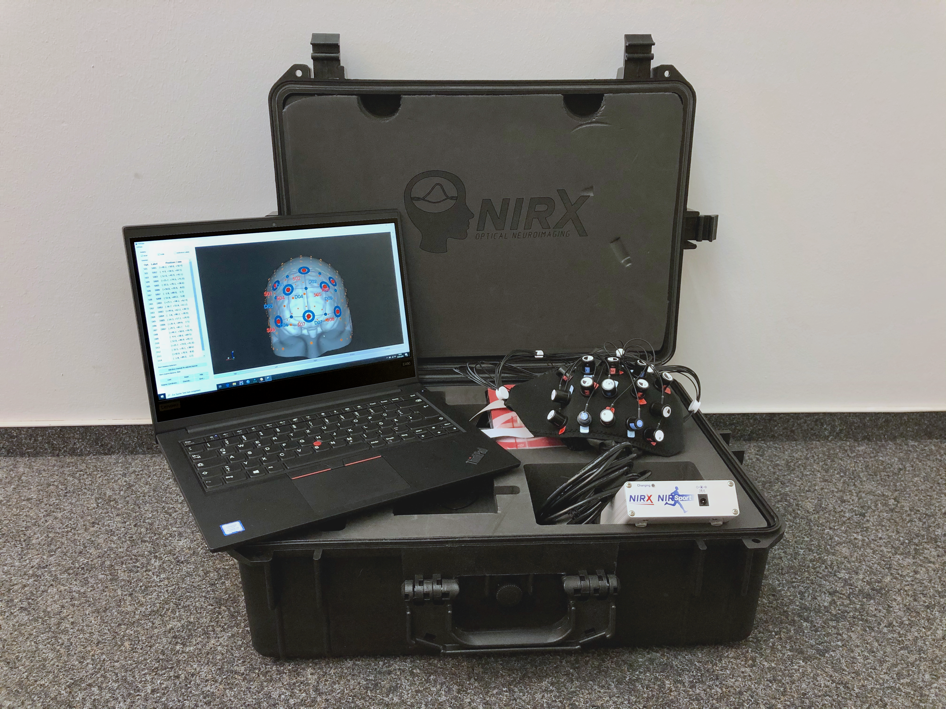
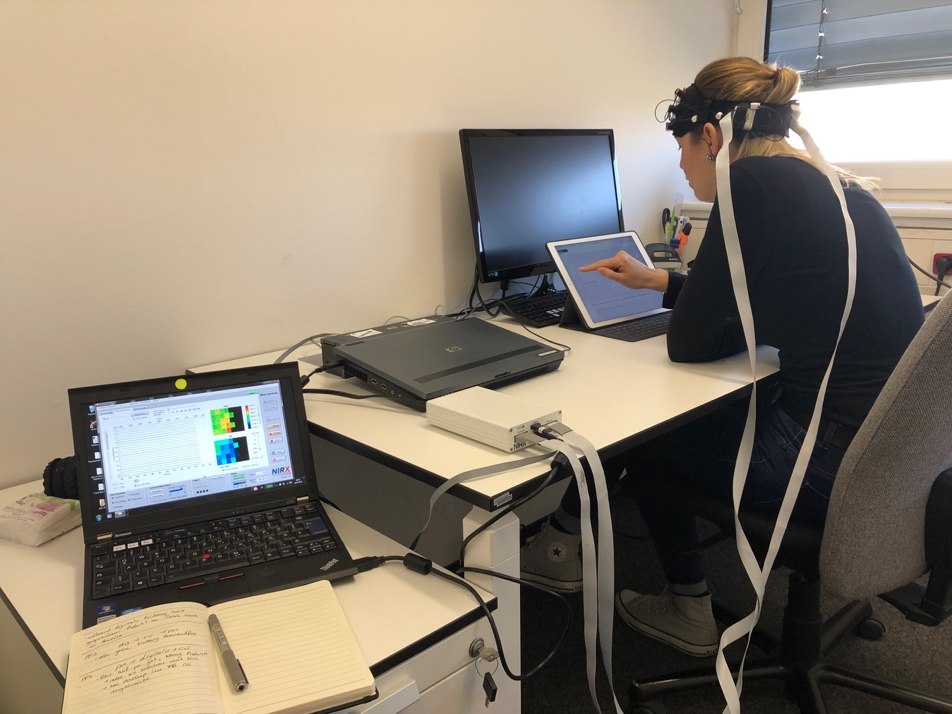
Fields of application (examples):
- Measuring the effect of graphical user interfaces on users with different foci, e.g. trust, user experience, cognitive load etc.
- Measurement of mobile applications in their context (e.g. apps), as we have a mobile fNIRS that can be used with backpack
- Consequently, customer reactions and experiences in physical stores could be measured to improve the store layout with this data
- It would also be possible to measure interpersonal actions, for example in IT project management teams
eLearning
eLearning methods & their effectiveness in the context of enterprise systems: In this project’s context, the processing of eLearning content in the brain is to be reproduced with the help of fNIRS. This should improve the efficiency and effectiveness of certain learning methods for the context of enterprise systems training by observing the human learning processes on a neural level.
(Your contact person for this: Mareen Wienand)

User Experience:
User Experience & information processing of graphical user interfaces: At this point, we investigate the effects of certain design characteristics of graphical user interfaces. The current focus lies on ecommerce websites and their graphical design. We also differentiate between the first impression and the first use, as well as investigate to what extent expectations change after the first use. In addition to user surveys and questionnaires, fNIRS is used to collect data which provide more in-depth insights into human information processing.
(Your contact for this: Anika Nissen)

Consumer Experience:
Digital Customer Experience & In-Store Experience: in the frame of this project, we investigate both online and offline customer experiences, for example while customers are visiting a website or strolling through a store in the city. Due to the mobility of the fNIRS, both use cases are possible, which allows us to conduct optimal field research. This helps us to measure the use of digital nudges on websites, or digital signages or nudges in supermarkets and thus, evaluate their effectiveness.

Social cognitive processing in Human-Robot Interactions:
Social cognitive processing in Human-Robot Interactions: In this research project, we investigate social categorizations and possible bias humans have against social robots. These processes might further heavily impact our interactions with robots. First, preliminary results in studies without fNIRS have already pointed to possible differences in the perceptions of robots and humans. Consequently, follow-up research including neural measurements by means of fNIRS are planned to gain deeper insights into general social processing of robots, the theory of mind, and the uncanny valley effect in human-robot interactions.
(Your contact person for this is Anika Nissen in cooperation with Katharina Jahn from University Siegen)

- Nissen, A.; Gier, N. R.: A Neural Investigation of eLoyalty on eCommerce Websites. In: International Conference on Information Systems (ICIS). 2021 , p. 1-17. CitationDetails
- Nissen, A.; Obermeier, G.; Gier, N. R.; Auinger, A.: Oh, What a Cognitive Relief! A NeuroIS Study on Visual Designs of Digital Signages. In: International Conference on Information Systems (ICIS). 2021 , p. 1-17. CitationDetails
- Nissen, A.; Krampe, C.: Why He Buys It and She Doesn’t – Exploring Self-Reported and Neural Gender Differences in the Perception of eCommerce Websites. In: Computers in Human Behavior Vol 121 (2021) No April . doi:10.1016/j.chb.2021.106809CitationFull textDetails
- Nissen, A.; Ersöz, S.: Towards a Psychophysiological Investigation of Perceived Trustworthiness and Risk in Online Pharmacies: Results of a Pre-study.. In: Davis, F. D.; Riedl, R.; Brocke, J. Vom; Léger, P. - M; Randolph, A. B.; ; Müller-Putz, G. (Ed.): Information Systems and Neuroscience. , p. 9-19. doi:10.1007/978-3-030-88900-5_2CitationDetails
- Nissen, A.; Obermeier, G.; Gier, N. R.; Schütte, R.; Auinger, A.: Consumers Prefer Abstract Design in Digital Signage: An Application of Fuzzy-Trace Theory in NeuroIS. In: NeuroIS Retreat 2021. 2021 . CitationDetails
- Nissen, A.; Riedl, R.: Design Mode, Color, and Button Shape: A Pilot Study on the Neural Effects of Website Perception. In: NeuroIS Retreat 2021. 2021 , p. 1-13. CitationDetails
- Nissen, A.: Psychological and Physiological Effects of Color Use on eCommerce Websites: a Neural Study Using fNIRS. In: International Conference on Information Systems (ICIS). Hyderabad, India 2020 . CitationAbstractDetails
Colors surround us in all life situations and have the power to influence our mood and emotions, which makes color a crucial impact factor for decision making in ecommerce environments. Therefore, this research paper aims to explore the psychological and physiological effects of color use on websites with a neuroimaging method. For this, an experiment was designed in which 24 healthy participants watched an online shoe shop in 4 different colored versions during which their neural activity in the prefrontal cortex was measured. While comparing the neural activity between the different employed colors, distinct implications can be derived. That is, in comparison to the blueish website, (1) grey scaled websites require higher cognitive load but are rated as aesthetically pleasing, (2) greenish websites result in more negative valence while they require not more neural resources, and (3) reddish websites are rated low in valence and require higher neural processing resources.
- Jahn, K.; Nissen, A.: Towards Dual Processing of Social Robots: Differences in the Automatic and Reflective System. In: International Conference on Information Systems (ICIS). Hyderabad, India 2020 . CitationAbstractDetails
Social robots increasingly diffuse into our lives in work, health, and many other areas. However, theoretical approaches that explain how social robots should be designed to maximize experiential and performance-related outcomes in human-robot interaction (HRI) are still rare. To close this research gap, we aim to develop a dual process model of HRI with the help of two experiments. Results of the first experiment show that individuals categorize humans and robots differently in the automatic and reflective system, leading to different forms of robotic biases in these systems. Specifically, whereas humans show a bias against all types of robots in the reflective system, they only show biases against robots with low anthropomorphism in the automatic system. With the second experiment, we aim to complement these results from a neurophysiological perspective to gain more insights into cognitive processes during classification and evaluation of robots.
- Nissen, A.: Why We Love Blue Hues on Websites: a fNIRS Investigation of Color and Its Impact on the Neural Processing of eCommerce Websites. In: Davis, F. D.; Riedl, R.; vom Brocke, J.; Léger, P-M.; Randolph, A.; Fischer, T. (Ed.): NeuroIS Retreat. Wien 2020 . CitationAbstractDetails
Blue of all colors seems to be generally preferred by humans and animals. Consequently, the use of this color in ecommerce context has several positive effects such as increased trustworthiness and aesthetic ratings. These effects are, in this study, hypothesized to be caused by specific neural processes in the prefrontal cortex of human decision makers. Consequently, this study tackles the research question whether there is a distinct neural activation pattern for blue websites that helps to explain why blue is often most favored. To investigate this, one website is designed and manipulated in col-or to which user reactions are measured by employing functional near-infrared spectroscopy (fNIRS). The results of this study show that blue colored websites seem to require generally less processing power related to cognitive while revealing increases in brain structures related to processing pleasant and aesthetic stimuli.
- Nissen, A.; Krampe, C.: Exploring Gender Differences on eCommerce Websites: A Behavioral and Neural Approach Utilizing fNIRS. In: Davis, F. D.; Riedl, R.; vom Brocke, J.; Léger, P-M.; Randolph, A.; Fischer, T. (Ed.): NeuroIS Retreat. Wien 2020 . CitationAbstractDetails
Whether males and females evaluate ecommerce websites differently has long been discussed and has resulted in inconsistent research findings. While some studies identified gender differences in the evaluation of websites, other studies indicate that these differences are inexistent. To shed light on these hypothetical gender differences on ecommerce website perceptions, a behavioral and functional near-infrared spectroscopy (fNIRS) experiment in which participants had to use and evaluate three different ecommerce websites was conducted. While the questionnaire-based behavioral results showed no significant differences between gender, neural gender differences could be discovered. In particular, well rated websites resulted in increased neural activity for men in brain regions of the dlPFC and vlPFC in the left hemisphere, while the lower evaluated websites resulted in an increased neural activity in brain regions of the vmPFC for men in the right hemisphere. Consequently, the results suggest that men seem to require higher neural activity for the emotional appraisal of, and decision making on ecommerce websites.
- Nissen, Anika; Krampe, Caspar; Kenning, Peter; Schütte, Reinhard: Utilizing Mobile fNIRS to Investigate Neural Correlates of the TAM in eCommerce. In: International Conference for Information Systems (ICIS) (2019) . CitationDetails
- Nissen, A.: Exploring the Neural Correlates of Visual Aesthetics on Websites. In: Davis, Fred D.; Riedl, René; vom Brocke, Jan; Léger, Pierre-Majorique; Randolph, Adriane; Fischer, Thomas (Ed.): Information Systems and Neuroscience. 1st Edition. Springer, Cham 2020 , p. 211-220. doi:10.1007/978-3-030-28144-1_23CitationDetails
News:
Thu, 20. May 2021 Busch, Jan
Journal-Artikel zur Wahrnehmung von eCommerce-Webseiten aus dem IIS fNIRS Lab publiziert
Wir freuen uns eine weitere Publikation aus unserem IIS fNIRS Lab zu verkünden: Anika Nissen und Caspar Krampe’s „Why he buys it and she doesn’t“-Paper wurde im Journal „Computers in Human Behavior“ akzeptiert. Im folgenden bekommt ihr erste Einblicke, worum es in dem Beitrag geht.
Why he buys it and she doesn't – Exploring self-reported and neural gender differences in the perception of eCommerce websites
Studies of gender-related differences in the perception of ecommerce websites dependent on the websites' aesthetics, usefulness, ease of use, and purchase intentions, give contradictory results. To shed light on these conflicting findings, in addition to self-reported data from two online questionnaires (Study 1 & Study 2), our research uses the neuroimaging method of functional near-infrared spectroscopy to explore possible gender-related differences (Study 3). By conducting three studies, users’ conscious and unconscious (neural) evaluations of ecommerce websites are explored. The self-reported results reveal that men and women do not significantly differ in their expressed evaluations of ecommerce websites. However, the neural results indicate that gender-related differences in the perception of ecommerce websites are influenced by unconscious effects, which might explain the inconsistent gender-specific research findings. Men tend to require greater neural activity when using ecommerce websites. Websites evaluated as useful and visually aesthetic lead to significant neural activation in brain regions of the left hemisphere for men in comparison to women, whereas websites evaluated as less useful and appealing reveal neural activation in brain regions of the right hemisphere in male participants. The results provide several theoretical and practical implications for the evaluation of gender-specific decision making on ecommerce websites.
Wenn ihr den vollen Beitrag lesen wollten, findet ihr ihn unter folgender Adresse: https://www.sciencedirect.com/science/article/abs/pii/S0747563221001321?via%3Dihub
Tue, 11. May 2021 Busch, Jan
Forschungsarbeiten aus unserem IIS fNIRS Lab auf NeuroIS-Konferenz akzeptiert
Drei Beiträge aus unserem IIS fNIRS Lab wurden auf der diesjährigen NeuroIS-Konferenz akzeptiert! Dabei streuen sich die abgedeckten Themen von Digital Signages bis hin zu Form und Fabre auf Webseiten. Im Folgenden sind die drei Arbeiten einmal kurz vorgestellt.
Design Mode, Color, and Button Shape: A Pilot Study on the Neural Effects of Website Perception
Authors: Anika Nissen and René Riedl
The investigation of website aesthetics has a long history and has already been addressed in NeuroIS research. The extant literature predominantly studied website complexity, symmetry, and colors. However, other design factors have not yet been examined so far. We studied two new factors (design mode: light vs. dark, button shape: rounded vs. sharp angled) along with color (blue vs. red). Specifically, we examined the impact of these three factors on several outcomes. Results from a repeated-measures MANOVA indicate: (i) design mode (light vs. dark) significantly affects users’ pleasure, arousal, trust, attitude, and use intention, (ii) color (blue vs. red) significantly influences pleasure, arousal, and use intentions, while (iii) button shape (rounded vs. sharp) does not significantly influence any of the dependent measures. Based on these results, follow up functional near-infrared spectroscopy studies are developed which aim to further complement our self-report findings.
Towards a Psychophysiological Investigation of Perceived Trustworthiness and Risk in Online Pharmacies: Results of a Pre-Study
Authors: Anika Nissen and Semra Ersöz
Perceived trustworthiness and risk are crucial impact factors for a website's success. While they have been frequently applied to diverse ecommerce contexts, an investigation of these constructs for the special case of online pharmacies is still scarce. In an attempt to measure these constructs in a neural experiment, this paper offers a pre-study with the aim to gain first insights and select appropriate stimuli for the upcoming study. Therefore, five operating online pharmacies are tested in an online survey with 121 participants which rated scales of perceived trustworthiness, perceived risk, attitude towards the website, and use intention for each of the included pharmacies. Results show that online pharmacies with high reputation are rated higher in the included constructs. Consequently, reputation, perceived risk, and trustworthiness are crucial impact factors on attitude and use intention. Thus, two promising online pharmacies could be selected for the follow-up study
Consumers Prefer Abstract Design in Digital Signage: An Application of Fuzzy-Trace Theory in NeuroIS
Authors: Anika Nissen, Gabriele Obermeier, Nadine Gier, Reinhard Schütte, & Andreas Auinger
Visual designs of digital signage (DS) content shape and influence consumers’ decisions. Understanding the effect of DS design on consumer behavior requires a fundamental understanding of human reasoning and decision-making. This research explores the effect of different visual design cues of DS on a neural level and through the lens of Fuzzy-Trace Theory (FTT). The FTT suggests that humans have both a verbatim-based and a gist-based information processing. To explore the effect of FTT-based visual design, an experiment using functional near-infrared spectroscopy is conducted. DS are tested on three design levels: (1) verbatim: text, (2) verbatim: photographs, and (3) gist-based. Results show that only the gist-based design resulted in significantly higher self-reported results and activated brain areas in the medial prefrontal cortex, which are associated with emotional and rewarding processing. These results challenge the mani- fest differentiation only between image and text elements.
Thu, 29. Apr 2021 Busch, Jan
Gesucht: Proband:innen für eine Studie zum Einkaufsverhalten in Online-Apotheken
Semra Ersöz und Anika Nissen von den Lehrstühlen Marketing und Handel sowie Wirtschaftsinformatik und integrierte Informationssysteme suchen Proband:innen für eine Studie zum Einkaufsverhalten in Online-Apotheken.
Mit der Studie soll die subjektive Wahrnehmung bei der Benutzung von Online-Apotheken untersucht werden. Dafür möchten Frau Ersöz und Frau Nissen, dass Proband:innen Online-Apotheken benutzen, während gleichzeitig das Gesicht gefilmt wird. Im Anschluss soll ein Fragebogen beantwortet und zuletzt eine Messung der aktivierten Hirnareale mittels Nahinfrarotspektroskopie durchgeführt werden. Das Verfahren ist nicht-invasiv, denn es wird ein Stirnband angebracht, welches den Sauerstoffgehalt des Blutes in den vorderen Teilen des Gehirns misst. Die Messung ist für den Körper völlig unschädlich und dauert ca. 10 Minuten. Insgesamt sollten Proband:innen 60 Minuten für die gesamte Studie einplanen. Als Aufwandsentschädigung erhält jede/r Proband:in 10 €.
Zeitraum der Studie: 03.05. bis 14.05.2021
Ort: Raum am Campus Essen
Sollten Sie Interesse an der Teilnahme an der Studie haben, wenden Sie sich an: .
Mon, 08. Jun 2020 Busch, Jan
Anika Nissen nimmt mit zwei Vorträgen an virtueller NeuroIS-Konferenz teil
Zwei eingereichte Beiträge von Anika Nissen wurden erfolgreich auf der diesjährigen NeuroIS-Retreat-Konferenz akzeptiert. Aufgrund der aktuellen Lage durch Covid-19 findet die Konferenz dieses Jahr virtuell über Microsoft Teams statt. Dabei treffen sich jährlich Wirtschaftsinformatiker, Betriebswirtschaftler und Neurowissenschaftler zum Austausch für NeuroIS bezogenen Themen. Wir freuen uns, dass unsere Beiträge zur Farbgestaltung bei Webseiten und neuronalen, geschlechtsspezifischen Unterschieden in der Informationsverarbeitung von Webseiten auf der Konferenz angenommen wurden und wir diese dort der Community präsentieren konnten. Nachfolgend sind die Abstracts der Vorträge zu finden:
Blue of all colors seems to be generally preferred by humans and animals. Consequently, the use of this color in ecommerce context has several positive effects such as increased trustworthiness and aesthetic ratings. These effects are, in this study, hypothesized to be caused by specific neural processes in the prefrontal cortex of human decision makers. Consequently, this study tackles the research question whether there is a distinct neural activation pattern for blue websites that helps to explain why blue is often most favored. To investigate this, one website is designed and manipulated in col-or to which user reactions are measured by employing functional near-infrared spectroscopy (fNIRS). The results of this study show that blue colored websites seem to require generally less processing power related to cognitive while revealing increases in brain structures related to processing pleasant and aesthetic stimuli.
Whether males and females evaluate ecommerce websites differently has long been discussed and has resulted in inconsistent research findings. While some studies identified gender differences in the evaluation of websites, other studies indicate that these differences are inexistent. To shed light on these hypothetical gender differences on ecommerce website perceptions, a behavioral and functional near-infrared spectroscopy (fNIRS) experiment in which participants had to use and evaluate three different ecommerce websites was conducted. While the questionnaire-based behavioral results showed no significant differences between gender, neural gender differences could be discovered. In particular, well rated websites resulted in increased neural activity for men in brain regions of the dlPFC and vlPFC in the left hemisphere, while the lower evaluated websites resulted in an increased neural activity in brain regions of the vmPFC for men in the right hemisphere. Consequently, the results suggest that men seem to require higher neural activity for the emotional appraisal of, and decision making on ecommerce websites.
Auch möchten wir hiermit nochmal den Veranstaltern für die hervorragende virtuelle Umsetzung der Konferenz danken.
Thu, 30. Jan 2020 Seufert, Sarah
Engagement in der NeuroIS-Forschung durch innovatives Forschungsgerät fNIRS
Zum Zweck der Forschung im innovativen Spannungsfeld zwischen Wirtschaftsinformatik und Neurowissenschaft hat der Lehrstuhl ein Forschungsgerät angeschaft. Genauer handelt es sich hierbei um eine funktionalen Nahinfrarotspektroskopie (fNIRS). Mit dieser können Hirnbereich mit erhöhter Aktvitität bei z.B. bestimmten Aufgaben, bestimmten Softwareprogrammen, bestimmten Webseiten etc. gemessen und analysiert werden. Dabei versucht diese Forschung nicht nur bestehende Phänomene, die üblicherweise mit Fragebögen gemessen werden, besser zu erklären, sondern auch über bestimmte Aktivierungsmuster Prognosen über Nutzerverhalten aufzustellen.
Mehr Infos zur Funktionsweise der fNIRS und unserer Ausstattung findet ihr hier: fNIRS LAB
Thu, 30. Jan 2020 Seufert, Sarah
IIS-Lehrstuhl auf der ICIS 2019 vertreten
Unsere Mitarbeiterin Anika Nissen ist zur ICIS 2019 gereist, um dort ihr Paper „Utilizing Mobile fNIRS to Investigate Neural Correlates of the TAM in eCommerce“ vorzustellen. In dem vorgestellten Paper geht es inhaltlich um die Messung der Nutzerakzeptanz mit den Konstrukten der wahrgenommenen Nützlichkeit und Einfachheit der Nutzung. Die Messung findet hier jedoch nicht subjektiv mit Hilfe von Fragebögen statt, sondern direkt am menschlichen Gehirn mithilfe der funktionalen Nahinfrarotspektroskopie (fNIRS).
Die ICIS ist dabei die größte, internationale Konferenz für Wirtschaftsinformatik, auf der sich alle bekannten Wirtschaftsinformatiker zum wissenschaftlichen Diskurs und Wissensaustausch treffen.
Zur Konferenzwebseite: https://icis2019.aisconferences.org/
Fri, 08. Nov 2019 Daumann, Lars
Unser eingereichter Beitrag auf der ICIS 2019 wurde akzeptiert.
Darin behandeln wir die neuronale Aktivität im menschlichen Präfrontalen Cortex auf Shopping Webseiten. Wie wir dabei vorgangen sind und welche Ergebnisse erzielt wurden fasst der folgende Abstract gut zusammen:
"The investigation of user behavior in IS contexts is often conducted by utilizing self-report measurements. To complement these measurements, neuroscientific methods have indicated their potential for IS research. Most pioneering research work utilized fMRI as neuroimaging method, which is associated with a decreased ecological validity. To investigate whether mobile fNIRS-an innovative, portable and lightweight neuroimaging method-can overcome the limited ecological validity of fMRI, reproducing existing neuroscientific research results, this study aims to explore whether mobile fNIRS could be used as a valid neuroimaging method for IS research, or more precisely for ecommerce research. Preliminary research findings revealed that fNIRS is capable of partly reproducing pioneering research results. Consequently, fNIRS is found to be a reliable and valid neuroimaging method to increase the ecological validity in IS research in certain situations and circumstances, providing a fruitful new avenue to investigate IS research relevant scenarios."
Link zum Orginialtext: Utilizing Mobile fNIRS to Investigate Neural Correlates of the TAM in eCommerce


